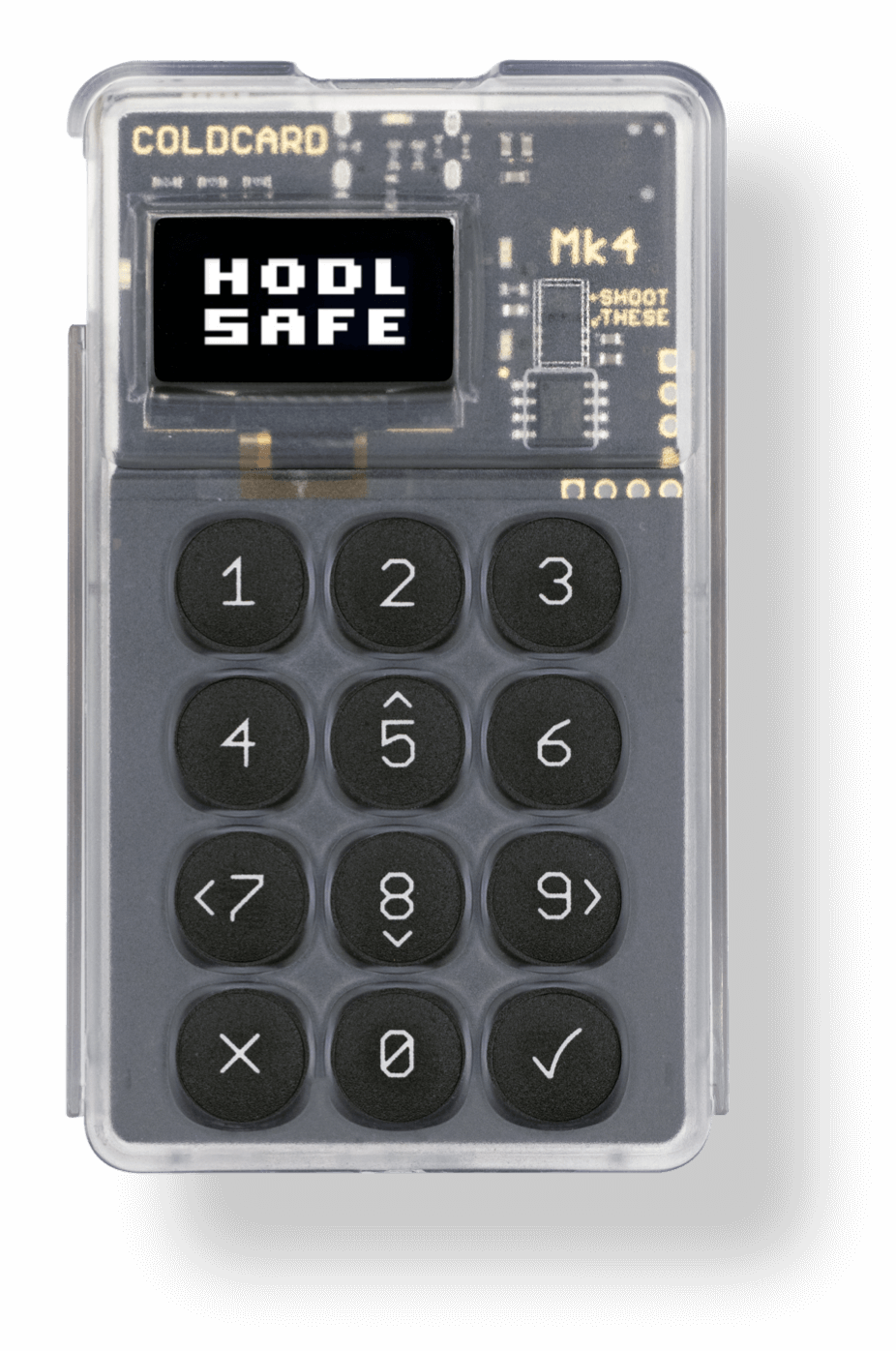Coldcard is a Cheap, Ultra-secure & Verifiable Hardware Wallet for Bitcoin. Get yours at Coldcard.com
Follow @COLDCARDwallet on Twitter to keep up with the latest updates and security alerts.
To have confidence this source code tree is the same as the binary on your device, you can rebuild it from source and get exactly the same bytes. This process has been automated using Docker. Steps are as follows:
-
Install Docker and start it.
-
Install make (GNUMake) if you don't already have it.
-
Checkout the code, and start the process.
git clone https://github.com/Coldcard/firmware.git
cd firmware/stm32
make repro
-
At the end of the process a clear confirmation message is shown, or the differences.
-
Build products can be found
firmware/stm32/built.
NOTE This is the master branch and covers the latest hardware (Mk4).
See branch v4-legacy for firmware which supports only Mk3/Mk2 and earlier.
Do a checkout, recursively to get all the submodules:
git clone --recursive https://github.com/Coldcard/firmware.git
Already checked-out and getting git errors? Do this:
git fetch
git reset --hard origin/master
Do not use a path with any spaces in it. The Makefiles do not handle that well, and we're not planning to fix it.
Then:
cd firmwaregit submodule update --init(if needed?)brew install automake autogen virtualenvvirtualenv -p python3 ENV(Python > 3.5 is required)source ENV/bin/activate(orsource ENV/bin/activate.cshbased on shell preference)pip install -r requirements.txt
Setup and Run the Desktop-based Coldcard simulator:
cd unix; make setup && make && ./simulator.py
Building the firmware:
cd ../cli; pip install --editable .cd ../stm32; make setup && make; make firmware-signed.dfu- The resulting file,
firmware-signed.dfucan be loaded directly onto a Coldcard, using this command (already installed based on above) ckcc upgrade firmware-signed.dfu
Which looks like this:
[ENV] [firmware/stm32 42] ckcc upgrade firmware-signed.dfu
675328 bytes (start @ 293) to send from 'firmware-signed.dfu'
Uploading [##########--------------------------] 29% 0d 00:01:04
You'll probably need to install at least these packages:
brew install --cask xquartz
brew install sdl2 xterm
brew install --cask gcc-arm-embedded
Used to be these were needed as well:
brew tap PX4/px4
brew search px4
brew install px4/px4/gcc-arm-none-eabi-80 (latest gcc-arm-none-eabi-XX, currently 80)
You may need to reboot to avoid a DISPLAY is not set error.
You may need to brew upgrade gcc-arm-embedded because we need 10.2 or higher.
defaults write org.python.python ApplePersistenceIgnoreState NOwill supress a warning aboutPython[22580:10101559] ApplePersistenceIgnoreState: Existing state will not be touched. New state will be written to...see https://bugs.python.org/issue32909
You'll need to install these (Ubuntu 20.04):
apt install build-essential git python3 python3-pip libudev-dev gcc-arm-none-eabi
Install and run simulator on Ubuntu 20.04
git clone --recursive https://github.com/Coldcard/firmware.git
cd firmware
# apply address patch
git apply unix/linux_addr.patch
# create virtualenv and activate it
python3 -m venv ENV # or virtualenv -p python3 ENV
source ENV/bin/activate
# install dependencies
pip install -U pip setuptools
pip install -r requirements.txt
# build simulator
cd unix
pushd ../external/micropython/mpy-cross/
make # mpy-cross
popd
make setup
make ngu-setup
make
# below line runs the simulator
./simulator.pyAlso make sure that you have your python3 symlinked to python.
Top-level dirs:
shared
- shared code between desktop test version and real-deal
- expected to be largely in python, and higher-level
- new code found only on the Mk4 will be listed in
manifest_mk4.pycode exclusive to earlier hardware is inmanifest_mk3.py
unix
- unix (MacOS) version for testing/rapid dev
- this is a simulator for the product
testing
- test cases and associated data
stm32
- embedded binaries (and building), for actual product hardware
- final target is a binary file for loading onto hardware
external
- code from other projects, ie. the dreaded submodules
graphics
- images which ship as part of the final product (icons)
stm32/bootloader
- 32k of factory-set code that you cannot change (Mk3)
- however, you can inspect what code is on your coldcard and compare to this.
stm32/mk4-bootloader
- 128k of factory-set code that you cannot change for Mk4
- however, you can inspect what code is on your coldcard and compare to this.
hardware
- schematic and bill of materials for the Coldcard
unix/work/...
-
/MicroSD/*files on "simulated" microSD card -
/VirtDisk/*simulated emulated virtual Disk files. -
/settings/*.aespersistant settings for Simulator
Found a bug? Email: support@coinkite.com

